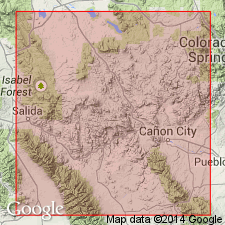
- Usage in publication:
-
- Gribbles Park Tuff*
- Modifications:
-
- Named
- Geochronologic dating
- Dominant lithology:
-
- Tuff
- AAPG geologic province:
-
- Denver basin
Summary:
Named for exposures along north and south sides of Gribbles Park, Fremont Co, CO in the Denver basin. Type locality selected where it caps mesas along north side of Gribbles Park in W1/2 sec 16 and E1/2 sec 17, T51N, R11E, and on Two Creek in E1/2 sec 5, T50N, R11E. Was called ash flow 7 in earlier reports. Divisible into three members which form a compound-cooling unit. The members are tuff; they weather (ascending order) brown, gray, and red, and have thicknesses of 240, 230, and 110 ft, respectively. The members are similar in composition, and are characterized by abundant chatoyant-blue sanidine crystals, bronze-colored biotite, and dark-brown and gray accessory lithic fragments. Pumice lapilli are less conspicuous in the lower brown and middle red members. Overlies Antero Formation, locally Thorn Ranch Tuff (new), and locally on prevolcanic rocks. Is older than the conglomerate of Fear Creek. Source is unknown, but probably is west of known outcrop area. Has normal polarity. K-Ar date on sanidine of 28.6 +/-0.6 and 29.5 +/-0.7 m.y. Assigned to the late Oligocene.
Source: GNU records (USGS DDS-6; Denver GNULEX).
For more information, please contact Nancy Stamm, Geologic Names Committee Secretary.
Asterisk (*) indicates published by U.S. Geological Survey authors.
"No current usage" (†) implies that a name has been abandoned or has fallen into disuse. Former usage and, if known, replacement name given in parentheses ( ).
Slash (/) indicates name conflicts with nomenclatural guidelines (CSN, 1933; ACSN, 1961, 1970; NACSN, 1983, 2005, 2021). May be explained within brackets ([ ]).

